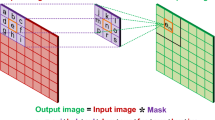Abstract
Inspired by biological eyes, silicon retinas with pixel-level processing have been developed to achieve very high-speed and high-quality image processing. Due to the limitation on the fill factor and the dimension of a silicon chip, both spatial and luminance resolutions have to be kept low. For recovering fine images from a silicon retina with a lower resolution, the authors propose a neural network model and its electronic counterpart by imposing random jitter to the sensor and collecting temporal statistics of the firing neurons. Statistical analysis shows that the scheme can enhance resolution of an image and emphasize contrast edges present in the image. It is further proved that the enhancement in luminance resolution and sharpness is a trade-off between recovering bias and variance. Therefore, jitter intensity needs to be optimized by considering the luminance distribution. The simulations illustrate its effect on the fine detail reconstruction using the proposed scheme.
















Similar content being viewed by others
References
Lee LP, Szema R (2005) Inspirations from biological optics for advanced photonic systems. Science 310(5751):1148–1150
Feng J (2003) Computational neuroscience: a comprehensive approach. CRC Press, Boca Raton
Cronin TW, Marshall J (2001) Parallel processing and image analysis in the eyes of mantis shrimps. Biol Bul 200:177–183
Ohta J (2007) Smart CMOS image sensors. CRC Press, Boca Raton
Mead C, Mahowald MA (1988) A silicon model of early visual processing. Neural Netw 1:91–97
Culurciello E, Etienne-Cummings R, Boahen KA (2003) A biomorphic digital image sensor. IEEE J Solid-State Circuits 38(2):281–294
Boahen K (2005) Neuromorphic microchips. Sci Am 292:56–63
Kurino H, Nakagawa M, Lee KW, Nakamura T, Yamada Y, Park KT, Koyanagi M (2001) Vision chip fabricated by using three dimensional integration technology. IEIC Tech Rep (Institute of Electronics, Information and Communication Engineers) 101(85):29–35
Forchheimer R, Åström A (1994) Near-sensor image processing: a new paradigm. IEEE Trans Image Process 3(6):736–746
Bernard TM, Nguyen PE, Devos FJ, Zavidovique BY (1993) A programmable VLSI retina for rough vision. Mach Vis Appl 7(1):4–11
Chen K, Åström A, Danielsson PE (1990) PASIC: a smart sensor for computer vision. Proceedings of the 10th international conference on pattern recognition, pp 286–291
Fowler B, El Gamal A, Yang DXD (1994) A CMOS area image sensor with pixel-level A/D conversion. Proceedings of the IEEE international solid state circuits conference, pp 226–227
Ditchburn RW, Ginsborg BL (1953) Involuntary eye movements during fixation. J Physiol 119(1):1–17
Ginsborg BL, Maurice DM (1959) Involuntary movements of the eye during fixation and blinking. Br J Ophthalmol 43(7):435–437
Martinez-Conde S, Macknik SL, Hubel DH (2004) The role of fixational eye movements in visual perception. Nat Rev Neurosci 5:229–240
Martinez-Conde S, Macknik SL, Hubel DH (2000) Microsaccadic eye movements and firing of single cells in the striate cortex of macaque monkeys. Nat Neurosci 3:251–258
Pitkow X, Sompolinsky H, Meister M (2007) A neural computation for visual acuity in the presence of eye movements. PLoS Biol 5(12):e331
Miller JA, Denning KS, George JS, Marshak DW, Kenyon GT (2006) A high frequency resonance in the responses of retinal ganglion cells to rapidly modulated stimuli: a computer model. Vis Neurosci 23(5):779–794
Greschner M, Bingard M, Rujan P, Ammermuller J (2002) Retinal ganglion cell synchronization by fixational eye movements improves feature estimation. Nat Neurosci 5:341–347
Rucci M, Iovin R, Poletti M, Santini F (2007) Miniature eye movements enhance fine spatial detail. Nature 447(7146):851–854
Donner K, Hemil S (2007) Modelling the effect of microsaccades on retinal responses to stationary contrast patterns. Vis Res 47(9):1166–1177
Propokopowicz P, Cooper P (1995) The dynamic retina. Int J Comput Vis 16:191–204
Landolt O, Mitros A (2001) Visual sensor with resolution enhancement by mechanical vibrations. Auton Robots 11(3):233–239
Hongler M, de Meneses YL, Beyeler A, Jacot J (2003) The resonant retina: exploiting vibration noise to optimally detect edges in an image. IEEE Trans Pattern Anal Mach Intell 25(9):1051–1062
Demler MJ (1991) High-speed analog-to-digital conversion. Academic Press, Inc., New York
Horn BKP (1998) Robot vision. MIT Press, Cambridge
Author information
Authors and Affiliations
Corresponding author
Rights and permissions
About this article
Cite this article
Yi, D., Jiang, P., Mallen, E. et al. Enhancement of image luminance resolution by imposing random jitter. Neural Comput & Applic 20, 261–272 (2011). https://doi.org/10.1007/s00521-010-0433-1
Received:
Accepted:
Published:
Issue Date:
DOI: https://doi.org/10.1007/s00521-010-0433-1




